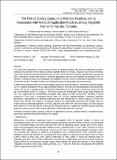| dc.contributor.author | Kiwango, Purificator Andrew | |
| dc.contributor.author | Kassim, Neema | |
| dc.contributor.author | Kimanya, Martin | |
| dc.date.accessioned | 2020-05-05T08:26:48Z | |
| dc.date.available | 2020-05-05T08:26:48Z | |
| dc.date.issued | 2018-02-19 | |
| dc.identifier.uri | https://doi.org/10.5539/jfr.v7n2p86 | |
| dc.identifier.uri | https://dspace.nm-aist.ac.tz/handle/20.500.12479/749 | |
| dc.description | This research article published by the Canadian Center of Science and Education, 2018 | en_US |
| dc.description.abstract | This study was conducted to assess dietary exposure to pesticide residues and pesticide application practices
leading to the presence of these residues among vegetable farmers in Arusha, Tanzania. Face-to-face interviews
using semi-structured questionnaires (including 24-hour recall and food frequency questionnaire techniques)
were conducted to collect information on pesticide application practices and vegetable consumption, from 76
farmers. A sample of ready-to-eat vegetables was collected from each farmer's household to determine the level
of pesticide residues. Pesticide residues were analyzed by gas chromatography-mass spectroscopy
A deterministic approach was used to assess dietary exposure to pesticide residues. Among the analyzed samples,
31.4% contained detectable levels of organophosphate residues. The detected organophosphates were dimethoate
(mean, 8.56 mg kg-1
), acephate (mean, 2.9 mg kg-1
), profenofos (mean, 8.44 mg kg-1
), dichlorvos (mean, 20.8 mg
kg-1
) and malathion (mean, 5.47 mg kg-1
). The mean exposure for dimethoate (0.0021 mg kg-1 body weight (wt)
day-1 was higher than its corresponding acceptable daily intakes of 0.002 mg kg-1
bwd-1
resulting in hazard
quotient of 1.044 with a consequent hazard index of 1.19 for organophosphates. Pyrethroid pesticides
(permethrin, cypermethrin, and lambda-cyhalothrin) were also detected but at a lower frequency (17.1%) and
hazard index (0.029). The exposure to pesticide residues was significantly associated with limited access to
expert advice on pesticide application (p=0.031, adjusted odds ratio=6.56) and over-dosage (p=0.038, adjusted
odds ratio=3.751).The risk may be minimized by increasing access to support by extension service providing
guidance on good practices and ensuring application of appropriate doses for pesticides. | en_US |
| dc.language.iso | en | en_US |
| dc.publisher | Canadian Center of Science and Education | en_US |
| dc.subject | Pesticide residue | en_US |
| dc.subject | Ready-to-eat | en_US |
| dc.subject | Application practices | en_US |
| dc.subject | Vegetable farmers | en_US |
| dc.subject | Agricultural extension officers | en_US |
| dc.subject | Over-dosage | en_US |
| dc.title | The Risk of Dietary Exposure to Pesticide Residues and Its Association with Pesticide Application Practices among Vegetable Farmers in Arusha, Tanzani | en_US |
| dc.type | Article | en_US |

